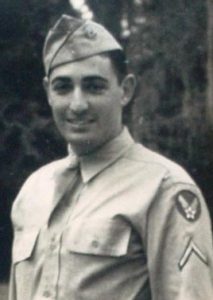Learn more about Herb Rosencrans, a hero of World War II
April 12, 2024The notice in The New York Times was like so many from 1945:
Pfc. Herbert J. Rosencrans, Company C, 415th Infantry, 104th Division, son of Mr. and Mrs. Alvin J. Rosencrans of Woodmere, L.I., who died of wounds last Feb. 25 in Arnoldsweiler, Germany, has received posthumously the Silver Star Medal, it was announced yesterday.
But who was Herb Rosencrans? He was the son Alvin and Eva, and the big brother of Bob. Beyond that, his letters reveal a thoughtful, talented, creative young man whose life was of unmeasurable value to the world.
At noon on Friday, April 26, at the South Carolina Confederate Relic Room and Military Museum in Columbia, Catherine Ladnier will deliver a free lecture about what she has learned from Herb’s letters to the folks back home. The program, “Tribute to a Jewish Soldier,” is part of the museum’s regular Noon Debrief series.
Catherine has spoken at the Relic Room twice before. The first time was in February 2022, when she spoke about letters to her father during the Second World War. Her fascination with what she learned from those treasures found among her late mother’s effects has led to many other projects. In this case, those letters led to her meeting Bob Rosencrans.
Bob led the kind of extraordinary life after the war that one might have expected for Herb. He died in 2016, and is remembered as a cable television industry pioneer who helped create C-SPAN. And when the aging Bob saw what Catherine had done with her father’s letters, he entrusted Herb’s letters to her.
They are wonderful to read, covering his life from college days into the Army, through training and the long fight across Europe. They are carefully crafted not to worry the folks back home, but leavened with an occasional glimpse of the battlefield and plenty of humor. Some samples:
• I’ve gone through the first week of training. … I haven’t seen a woman now in about a week and believe me I see now that it would be mighty hard to live without them. However, after that sex movie they gave us, everyone here intends to wear gloves when they even shake hands with a woman….
• … I went to a college dance Saturday night. There are hardly any Jewish girls on the campus. This is one place where a girl named Bunny could do a lot for the morale of the soldiers. You’d be surprised at the persuasive powers of a khaki uniform. From generals down to privates, we’re all wolves!…
• What a collection of soldiers in my unit. For example, we have in my barracks alone an artist —— a bartender from the Stork Club ——– an Annapolis washout — and a school teacher!… Tomorrow will be the test to determine whether or not we will go overseas as a Division or as individual replacements. That means a lot to us because it is a tough deal to replace soldiers who have died in action…
• I long for the end of this war more all the time… Whenever I have time to think—which is seldom—I feel a pride in the history making job we are doing. Each 24 hours brings me closer to the day when I can say goodbye to Europe. I try to contain myself from being over-optimistic because I also know that there are bitter days ahead for us doughboys. I also do a quite a bit of praying….
According to that story in The Times, on Feb. 25, 1945, Herb was leading his squad forward in an enemy town when they met a large number of German troops preparing to counterattack. “Exposing himself to enemy artillery fire to determine the location of the enemy, he then organized a strong defense. When the enemy attacked, he led his men in a furious fight, inflicting heavy losses on the enemy. He was fatally wounded.”
Learn more about him on April 26 at the Relic Room.
About the South Carolina Confederate Relic Room and Military Museum
Founded in 1896, the South Carolina Confederate Relic Room and Military Museum is an accredited museum focusing on South Carolina’s distinguished martial tradition through the Revolutionary War, Mexican War, Civil War, Spanish-American War, World Wars I and II, Vietnam, the War on Terror, and other American conflicts. It serves as the state’s military history museum by collecting, preserving, and exhibiting South Carolina’s military heritage from the colonial era to the present, and by providing superior educational experiences and programming. It recently opened a major new exhibit, “A War With No Front Lines: South Carolina and the Vietnam War, 1965-1973.” The museum is located at 301 Gervais St. in Columbia, sharing the Columbia Mills building with the State Museum. For more information, go to https://crr.sc.gov/.














